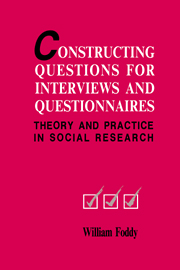Book contents
- Frontmatter
- Contents
- Tables
- Figures
- Preface
- Chapter 1 An initial statement of the problem
- Chapter 2 A theoretical framework
- Chapter 3 Defining topics properly
- Chapter 4 Formulating intelligible requests for information
- Chapter 5 Contextual influences on respondents' interpretations of questions
- Chapter 6 The need to provide response frameworks
- Chapter 7 The limitations of human memory
- Chapter 8 Filters: establishing the relevance of questions to respondents
- Chapter 9 Reducing question threat
- Chapter 10 The open vs. closed questions debate
- Chapter 11 Measuring attitudes
- Chapter 12 Checks to ensure that questions work as intended
- Chapter 13 Concluding comments
- The tap paradigm
- References
- Index
- Acknowledgements
Preface
Published online by Cambridge University Press: 04 September 2009
- Frontmatter
- Contents
- Tables
- Figures
- Preface
- Chapter 1 An initial statement of the problem
- Chapter 2 A theoretical framework
- Chapter 3 Defining topics properly
- Chapter 4 Formulating intelligible requests for information
- Chapter 5 Contextual influences on respondents' interpretations of questions
- Chapter 6 The need to provide response frameworks
- Chapter 7 The limitations of human memory
- Chapter 8 Filters: establishing the relevance of questions to respondents
- Chapter 9 Reducing question threat
- Chapter 10 The open vs. closed questions debate
- Chapter 11 Measuring attitudes
- Chapter 12 Checks to ensure that questions work as intended
- Chapter 13 Concluding comments
- The tap paradigm
- References
- Index
- Acknowledgements
Summary
More than forty years ago, George Gallup (1947:385), the director of the American Institute of Public Opinion, observed that:
students of public opinion are fast coining to the realization that, relatively speaking, too much attention has been directed toward sample design, and too little toward question design … differences in question design often bring results which show far greater variation than those normally found by different sampling techniques …
Thirty years later, Gallup felt the need to repeat these views in a foreword to a reprinting of Stanley Payne's classic work, The Art of Asking Questions (1951):
While great strides have been made in improved sampling design and technique – and electronic data processing has given us almost immediate access to the survey findings themselves – there has not been a comparable amount of progress in perfecting question or questionnaire design.
About the same time similar comments were made by Belson (1981:11) in his introduction to a report of a major investigation that he and his colleagues had conducted on the way respondents interpret survey questions:
At the time this study was designed, relatively few reports of empirically based research into the understanding of survey questions had been published. Since the appearance of the present report in mimeograph form, very little else has appeared. It is to nobody's credit that anything so important to survey research should have been so neglected.
- Type
- Chapter
- Information
- Constructing Questions for Interviews and QuestionnairesTheory and Practice in Social Research, pp. ix - xiiPublisher: Cambridge University PressPrint publication year: 1993

